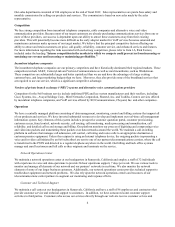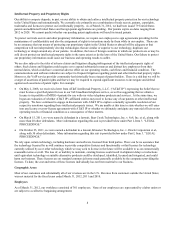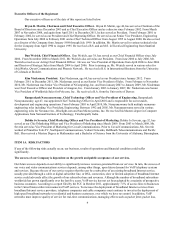8x8 2012 Annual Report Download - page 18
Download and view the complete annual report
Please find page 18 of the 2012 8x8 annual report below. You can navigate through the pages in the report by either clicking on the pages listed below, or by using the keyword search tool below to find specific information within the annual report.16
Until 2007, we did not collect or remit state or municipal taxes, such as sales, excise, and ad valorem taxes, fees or surcharges
on the charges to our customers for our services, except that we have historically complied with the collection of California
sales tax and financial contributions to the 9-1-1 system and the federal Universal Service Fund. We have received inquiries or
demands from a number of state and municipal taxing agencies seeking payment of taxes, fees or surcharges that are applied to
or collected from customers of providers of traditional public switched telephone network services. Although we have
consistently maintained that these taxes, fees or surcharges do not apply to our service for a variety of reasons depending on the
statute or rule that establishes such obligations, a number of states have changed their statutes as part of streamlined sales tax
initiatives and we are now collecting and remitting sales taxes in those states. The collection of these taxes, fees or surcharges
will have the effect of decreasing any price advantage we may have over other providers who have historically paid these taxes
and fees. Our compliance with these tax initiatives will also make us less competitive with those competitors who choose not to
comply with these tax initiatives. Currently, three jurisdictions are conducting sales tax audits of our records. As of March 31,
2012, there has been no change in the status of the assessment.Wecollectandhaveaccruedfortaxesthatwebelieveare
to fines or other imposed penalties, or harm the perception and adoption rates of our service, any of which would have a
material adverse effect on our business, financial condition or operating results.
Our ability to offer services outside the U.S. is subject to different local regulatory environments, which may be
unknown, complicated and uncertain.
Regulatory treatment of VoIP telephony outside the United States varies from country to country and often the laws are
unclear. We currently distribute our products and services directly to consumers and through resellers that may be subject to
telecommunications regulations in their home countries. The failure by us or our customers and resellers to comply with these
laws and regulations could reduce our revenue and profitability. Because of our relationship with the resellers, some countries
may assert that we are required to register as a telecommunications provider in that country. In such case, our failure to do so
could subject us to fines or penalties. In addition, some countries are considering subjecting VoIP services to the regulations
applied to traditional telephone companies. Regulatory developments such as these could have a material adverse effect on the
use of our services in international locations.
Acquisitions may divert our management’s attention, result in dilution to our stockholders and consume resources that
are necessary to sustain our business.
In fiscal 2012, we made two business acquisitions. In fiscal 2011, we made one acquisition and one investment in another
company and, if appropriate opportunities present themselves, we may make additional acquisitions or investments or enter
into joint ventures or strategic alliances with other companies. Risks commonly encountered in such transactions include:
• The difficulty of assimilating the operations and personnel of the combined companies;
• The risk that we may not be able to integrate the acquired services or technologies with our current services, products,
and technologies;
• The potential disruption of our ongoing business;
• The diversion of management attention from our existing business;
• The inability of management to maximize our financial and strategic position through the successful integration of the
acquired businesses;
• Difficulty in maintaining controls, procedures, and policies;
• The impairment of relationships with employees, suppliers, and customers as a result of any integration;
• The loss of an acquired base of customers and accompanying revenue;
• The assumption of leased facilities, other long-term commitments or liabilities that could have a material adverse impact
on our profitability and cash flow; and
• The dilution to our existing stockholders from the issuance of additional shares of common stock or reduction of
earnings per outstanding share in connection with an acquisition that fails to increase the value of our company.
As a result of these potential problems and risks, businesses that we may acquire or invest in may not produce the revenue,
earnings, or business synergies that we anticipated. In addition, there can be no assurance that any potential transaction will be
successfully identified and completed or that, if completed, the acquired business or investment will generate sufficient revenue
to offset the associated costs or other potential harmful effects on our business.
Increased taxes on our service will increase our customers' cost of using our service and/or reduce our profit margins
(to the extent the costs are not passed through to our customers) and we may be subject to liabilities for past sales and
additional taxes, surcharges and fees.
























